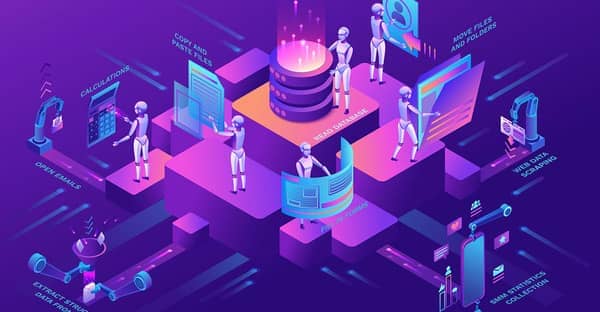Getting Hacked in 2017
November 18, 2022
Technology News Recap
January 3, 2023Artificial intelligence and machine learning have been depicted in television in film for decades. Robotic Process Automation (RPA) is not what it may sound like. It isn’t the next chapter of the sci-fi film depicted in the future where robots take over the world. While these “robots” emulate human actions interacting with other digital systems and software—we’re quite far from how these technologies are depicted in media. Let’s discuss robotic process automation and how it can make businesses more efficient.
What Is Workflow Automation?
Workflow automation allows organizations to improve their everyday business productivity. Workflow is defined as a sequence of actions that are needed to complete a certain task. Workflow automation moves the required action to the software program instead of human workers.
Automating workflow first requires identifying what actions are needed to complete a task, and what tasks are needed to fulfill a particular job. Next, rules and logic are created to manage how these actions and tasks must be done. After these are in place, programming the software with rules and logic will allow the system to work similarly to its human counterpart.

The basic workflow automation steps are identifying the processes, mapping out the process, defining business goals, researching, implementing the software, training staff to use the software, establishing metrics, and finally using the metrics to make the workflow automation more efficient.
Workflow automation can be used to organize documents for approval and signing. It can move staff, partners, and clientele through various processes. Workflow automation can facilitate sales, invoicing, and other accounting-related processes. On the customer side, it can also respond to current and potential customers regarding inquiries and other communication.
It’s used in various industries including legal, financial, sales, human resources, healthcare, information technology, marketing, cybersecurity, operations, and more.
Various types of workflow automation include business process (BP), Robotic Process (RP) workflows, and Robotic Process Automation (RPA). Robotic Process Automation works a bit differently than the first two because it is more useful for automating individual tasks that are discrete.

What Is Robotic Process Automation (RPA)?
When you hear robotic process automation, you may associate this with the many artificial intelligent robot television shows or films like “I Robot”, “Chappie”, “Ex Machina”, or “Westworld”, but RPA isn’t what you may think. Robotic Process Automation doesn’t even involve any labor-intensive undertakings associated with normal human chores. RPA doesn’t encompass robots that do heavy lifting, cleaning, or anything physical.
Robotic Process Automation doesn’t involve any physical robots, but instead, it refers to a “robotic” virtual system used to automate various repetitive manual computing or process tasks. RPA is software that allows users to easily develop, implement, and control software bots or “robots” that simulate the way humans communicate with digital systems and software.
RPA is a type of workflow automation. These software bots are intended to perform quicker and more efficiently than humans without the need for breaks. RPA can even log into certain applications, enter data, view emails, open attachments, count and complete various tasks, and log out. While Robotic Process Automation can improve business operations it can potentially make certain jobs obsolete.
What Are Examples of Robotic Process Automation?
There are various examples that Robotic Process Automation is being used in a real-world setting. For example, RPA makes it simpler and easier to help customer inquiries in a call center operation. If you’ve called one of these call centers requesting help, you may have been transferred from one agent to another. RPA technology will allow human workers to see everything pertinent regarding the customer’s inquiry. And instead of the customer being transferred multiple times, they could receive help more efficiently.
Robotic Process Automation can also be beneficial when an organization transfers data from one system to another. If a system isn’t backed up correctly, organizations can lose essential data during a data transfer. Restoring backup data can be a time-consuming process. Robotic Process Automation can be beneficial during a data transfer and restore lost data. Having an RPA system will make moving data more efficient and will reduce the amount of human error. This is especially true if the staff is not trained, data professionals.

RPA technology is also beneficial for processing customer orders. When a customer orders a product, a similar process happens from beginning to end. When someone from the company manually handles these tasks, it can be laborious and inefficient. Using Robotic Process Automation can manage a customer’s order and process it faster and more efficiently. This can improve multiple aspects of the business including human error, lower costs, and increase the satisfaction of all customers.
Robotic Process Automation can also help a company’s compliance. As an organization grows, the need to monitor the upkeep of compliance can be difficult. RPA can be advantageous for companies that need to ensure all of their employees are working under the proper compliance requirements.
RPA can also help with research in a variety of ways. One of which is looking over websites, isolating and extricating data that is relevant. Using Robotic Process Automation can scour the entire internet to find content that can be useful for the user’s needs. This process can make finding relevant and trusted information faster than having multiple people find it manually.
Conclusion
Workflow automation and Robotic Process Automation can be beneficial to many different organizations in various industries. It can boost productivity, improve efficiency and save a company money, improve a business’s data security, generate data for better business analytics, and improve customer service. While Robotic Process Automation isn’t the introduction of robots that come to mind as depicted in science-fiction television and film—it is making many organizations in various industries more efficient. Robots may not be taking over the world just yet, but they are making certain tasks and jobs a little bit easier.

